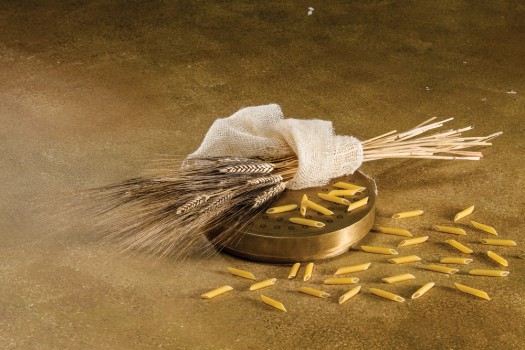Pasta with Personality- Foodie Facts Part 2
In our last post we shared the history of Old World pasta making. Today we’re talking about some new world production methods and why we think bronze dies are where it’s at in the pasta with personality world.
Bronze dies are the Gold Medal Standard in our book.
Most commercially manufactured pasta is made using dies that have been coated with Teflon. This helps increase their production speeds. We use ONLY bronze dies which create pasta that has a rougher texture and greater porosity, allowing it to better hold sauce.
Mmm, did somebody say “sauce”? Great pasta is a vehicle for the sauce. [Tweet this]
Fun Fact: If you look at the surface of pasta made with bronze dies, it has a paler color different from the cheaper more common pasta which has a shiny surface. Pasta that is extruded through bronze dies has a “dusty” look whereas pastas that are extruded through Teflon coated dies have a brighter color and are “shiny”.
The back of a die contains inserts with a series of holes which determine the size and shape of the pasta. We create pasta with personality ™ shapes that are the most relevant for the theme of the pasta and also determine which shapes will extrude the best. Our bronze dies are highly engineered on CAD systems and custom made for us in one of the oldest family run die companies in Italy.
Fun Fact: Mechanical drying of pasta was not invented until 1800. (Gragnano is a hill town; home to some of the best dried pasta in Italy- Gragnano’s main street was laid out expressly to capture the mountain breeze mixed with sea air back when pasta makers hung spaghetti on drying rods like laundry.)
To dry or not to dry, that is the question. Our drying process…
Our drying process is much longer than most pasta. We dry the pasta in specialty Italian dryers for up to 24 hours compared to the typical drying time of just a few hours. The drying time is critical because if the pasta is dried too quickly it will “check” and if it is dried too slowly, the risk of spoilage increases. “Checking” is when pasta has been dried incorrectly and small cracks appear on the pasta surface. When cooked, the pasta will break apart. If pasta is under-dried molding can occur. NOT good. We dry our pasta at lower temps over a longer period of time achieving the great texture and quality…that is our standard.
Quality products with consistent results.
Fun Fact: A sign of good quality pasta is that it holds its shape and texture through the cooking process and doesn’t cloud the water. Large manufacturers spray their pastas with starch to speed up the production process and that excess starch gets released into the pasta water. Cloudy water is a sign that pasta contains too much starch which is being released into the boiling water.
So, have you learned something new about the history of pasta and pasta production? Interested in trying our pasta with personality for your next Fundraiser? Contact us now to request free information?

